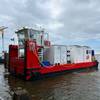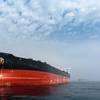The ports surrounding New York City, which handle most of the cargo arriving on the East Coast of the United States, must have deeper channels to stay viable and competitive, port commerce officials warn.
The New York/New Jersey port complex, by far the biggest on the Atlantic seaboard, expects the amount of cargo it handles to double over the next 10 years, but only if shipping lanes can be made deep enough to handle the next generation of massive container vessels.
That means digging up more of the seabed and finding a way to dispose of resulting muck, some of which is highly contaminated, in the face of tough environmental laws.
"Looking at it conservatively, we will double our cargo within 10 years. We're keenly aware we must improve our cargo- handling capacity and also dredge deeper channels in the harbor," said Richard Larrabee, director of the port commerce department at the Port Authority of New York and New Jersey.
The huge shipping terminal facilities located around the shores of Staten Island and in New Jersey's Port Newark and Port Elizabeth handle 11 percent of all the ocean-borne general cargo imported into the United States and 58 percent of the cargo arriving on the East Coast.
The New York port complex is also the top refined petroleum port in the nation and leads the country for automobile imports and exports. It serves a market of 18 million in the immediate area and provides two-day access to 80 million other consumers in the Midwest, mid-Atlantic and eastern Canada.
This year, the port will handle 3 million containers. In the first quarter alone, in the face of a national economic slowdown, business grew by 9 percent compared to the same period in 2000.
Yet all that activity could be put into jeopardy unless the port spends at least $3.5 billion in the next 15 years to adapt itself to the cargo behemoths now under construction.
As recently as 1995, more than 80 percent of all container traffic worldwide was carried on ships with drafts of less than 40 feet (12 m).
Experts believe that by 2020, 65 percent will be carried by ships with drafts of more than 40 feet (12 m), including 30 percent carried by ships with drafts exceeding 45 feet (13.6 m). As ships get bigger, they will also probably call at fewer ports than before.
The key is dredging the shipping lanes leading to the docks from a depth of about 35 feet (10.6 m) to 45 feet (13.6 m) by 2004 and eventually to 50 feet (15 m), which the port authority hopes to accomplish by 2009 at a cost of $2.8 billion.
But that plan creates a problem. What happens to the silt and muck and clay and rock dredged or blasted from the seabed -- an estimated 60.5 million cubic yards of material, of which 8.5 million will be contaminated to some extent with traces of heavy metals, organic compounds and dioxins?
Much of the contamination is low-level, but some highly contaminated pockets exist within the harbor area.
"The virgin material, clay and gravel, that they will dig up, presents no particular problem. The other stuff -- the contaminated stuff -- presents a considerable problem," said Roy Stoecker of EEA Inc. an environmental consulting firm specializing in marine biology issues.
According to Larrabee, it costs about $4 per cubic yard to dump dredged material out at sea. It costs up to $80 to dispose of the same amount of material on land.
But stricter environmental regulations mean that officials must choose the more expensive option to get rid of much of the material dredged from the New York shipping lanes.
In 1988, largely in response to protests against ocean dumping of sewage sludge, Congress approved legislation that prohibited the disposal at sea of any substance containing material other than trace contaminants. Subsequent orders from the Environmental Protection Agency have tightened controls even more.
"It's been an extremely difficult procedure. On one hand, you have environmental activists, fishermen's groups and shorefront community groups protesting the dumping of material either at sea or anywhere near them. On the other, the survival of the port as a viable and competitive entity is based on the ability to deepen the channels," said Stoecker.
Some of the most contaminated materials will have to be dumped in landfills and capped. Cleaner material is easier to dispose of -- some could even be sold or used to replenish beaches.
According to the American Society of Civil Engineers (ASCE), national investment in the nation's 1,000-plus harbor channels and 25,000 miles (40,000 km) of inland, intracoastal and coastal waterways has lagged badly in recent years.
"In the short term, service will be sustained. However, the aging infrastructure and deferred maintenance created by insufficient investment levels will result in degraded system performance, safety concerns, increased delays, higher transportation costs for goods and services and negative impacts on GDP and employment," the ASCE said in a report.
In New York, where 166,500 jobs are believed to be directly or indirectly related to port operations, money and political will do not seem to be the problem. But geographical factors impose their own constraints.
With virtually no room for expansion in a crowded metropolitan area, the ports must raise efficiency if they are to handle the increased volume of cargo that is predicted. Larrabee wants to raise the "throughput" at container terminals from 1,500 containers per acre (0.4 hectare) per year to at least 3,500.
That step means investing in new cranes and container- stacking systems and building better rail and road infrastructure. Port officials are even consulting with experts from the port of Rotterdam in the Netherlands to see if they can develop barge operations from the port to inland distribution centers. - (Reuters)
Subscribe for
Maritime Reporter E-News
Maritime Reporter E-News is the maritime industry's largest circulation and most authoritative ENews Service, delivered to your Email five times per week










